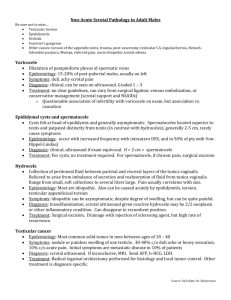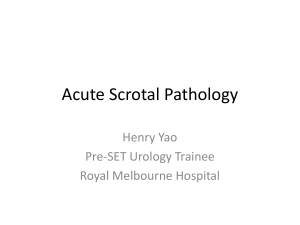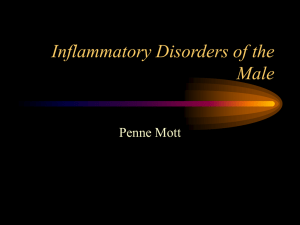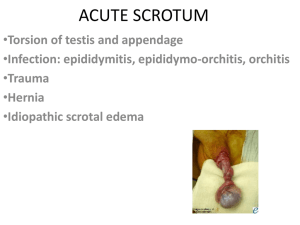- e
advertisement
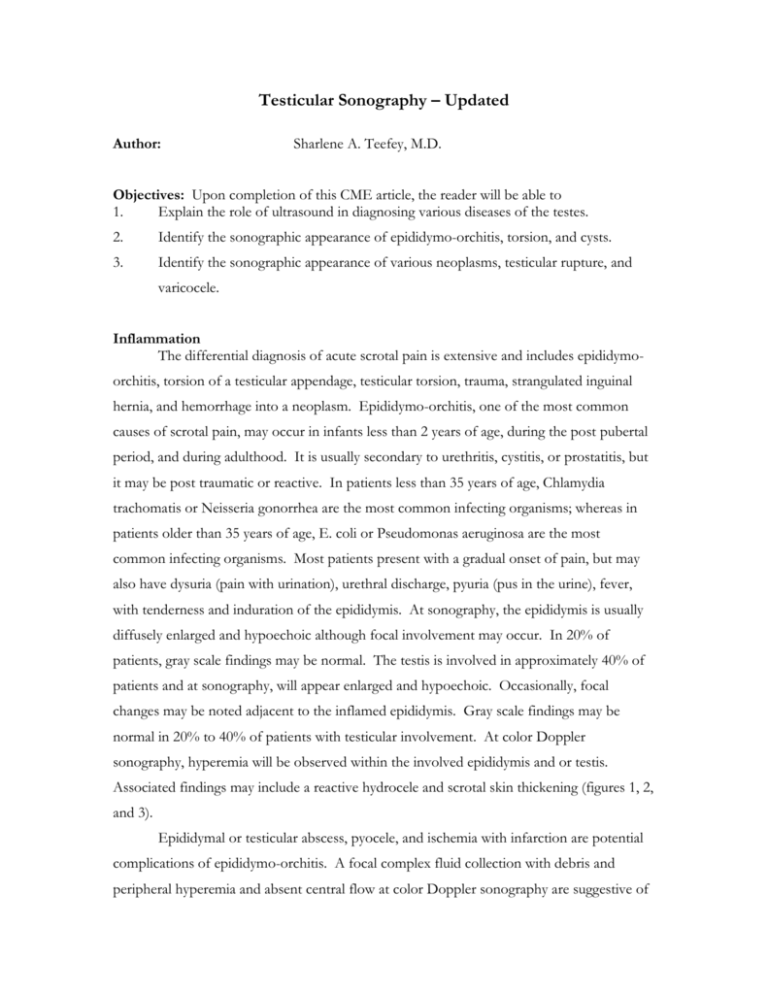
Testicular Sonography – Updated Author: Sharlene A. Teefey, M.D. Objectives: Upon completion of this CME article, the reader will be able to 1. Explain the role of ultrasound in diagnosing various diseases of the testes. 2. Identify the sonographic appearance of epididymo-orchitis, torsion, and cysts. 3. Identify the sonographic appearance of various neoplasms, testicular rupture, and varicocele. Inflammation The differential diagnosis of acute scrotal pain is extensive and includes epididymoorchitis, torsion of a testicular appendage, testicular torsion, trauma, strangulated inguinal hernia, and hemorrhage into a neoplasm. Epididymo-orchitis, one of the most common causes of scrotal pain, may occur in infants less than 2 years of age, during the post pubertal period, and during adulthood. It is usually secondary to urethritis, cystitis, or prostatitis, but it may be post traumatic or reactive. In patients less than 35 years of age, Chlamydia trachomatis or Neisseria gonorrhea are the most common infecting organisms; whereas in patients older than 35 years of age, E. coli or Pseudomonas aeruginosa are the most common infecting organisms. Most patients present with a gradual onset of pain, but may also have dysuria (pain with urination), urethral discharge, pyuria (pus in the urine), fever, with tenderness and induration of the epididymis. At sonography, the epididymis is usually diffusely enlarged and hypoechoic although focal involvement may occur. In 20% of patients, gray scale findings may be normal. The testis is involved in approximately 40% of patients and at sonography, will appear enlarged and hypoechoic. Occasionally, focal changes may be noted adjacent to the inflamed epididymis. Gray scale findings may be normal in 20% to 40% of patients with testicular involvement. At color Doppler sonography, hyperemia will be observed within the involved epididymis and or testis. Associated findings may include a reactive hydrocele and scrotal skin thickening (figures 1, 2, and 3). Epididymal or testicular abscess, pyocele, and ischemia with infarction are potential complications of epididymo-orchitis. A focal complex fluid collection with debris and peripheral hyperemia and absent central flow at color Doppler sonography are suggestive of an epididymal or intra-testicular abscess. Sonographic findings of a pyocele include a complex fluid collection with septations and or debris. Ischemia with infarction is a serious complication of epididymo-orchitis. If there is extensive cord and epididymal inflammation, venous outflow obstruction may result causing diastolic flow reversal or absence of flow within the testis leading to tissue damage. Torsion Testicular torsion may occur at any age but its peak incidence is in the newborn and between the ages of 12 and 18. In the newborn, it is due to a congenital “bell-clapper” deformity in which the tunica vaginalis envelops the entire testis and epididymis allowing it to swing freely within the tunica and thus potentially twist. This finding may be bilateral in up to 43% of patients. Testicular torsion is often associated with trauma or exertion. Pain is usually acute in onset (although up to 25% of patients may experience a gradual onset). Nausea, vomiting, and anorexia may also occur and are fairly specific for torsion. Fever and voiding symptoms are usually absent. On physical examination, the testis is usually enlarged and tender and in an abnormal position (“high-riding” testis) (figures 4 and 5). Viability of the testis is related to the duration and degree of torsion. If torsion has been present for less than 6 hours, the salvage rate is 97% to 100%. If it has been present for 7 to 12 hours, there is a 57% salvage rate, dropping to 35% if the torsion has been present for 13 to 24 hours. The sonographic findings of testicular torsion are related to the duration of the torsion. When present less than 6 hours, the testis and epididymis are frequently normal in their gray scale appearance. When torsion is present greater than 6 hours to 10 days, the testis and epididymis are usually enlarged, hypoechoic, and heterogeneous. When present greater than 10 days, the testis is often small, hypoechoic, and heterogeneous. The epididymis may remain enlarged and heterogeneous. At duplex and color Doppler sonography, there is absent or markedly decreased intra-testicular blood flow on the affected side. Miscellaneous findings include scrotal skin thickening, a reactive hydrocele, extra-testicular hemorrhage, and sonographic visualization of the torsion knot. Cysts There are many different types of cystic lesions that involve the testes. Tubular ectasia of the rete testis and non-neoplastic cysts (tunica albuginea and intra-testicular) are two of the more common types of cystic lesions. Tubular ectasia of the rete testis is most frequently seen in middle aged to elderly men and is often a bilateral process. It has been reported to be congenital or mechanical in origin (i.e. due to compression by tumor or a chronic epididymitis) but ischemia or a hormonal etiology has also been proposed. At sonography, multiple varying sized tubular or rounded anechoic cysts are observed within the mediastinum testes. Spermatoceles are also frequently associated with tubular ectasia. Two of the more common non-neoplastic cysts of the testes are tunica albuginea cysts and intra-testicular cysts. Tunica albuginea cysts may be embryologic in origin or the result of trauma or infection. They are palpable due to their subcapsular location and usually measure less than 10 mm in size. At sonography, tunica albuginea cysts are anechoic and may have septae. Intra-testicular cysts are located within or adjacent to the rete testis and therefore are not palpable. Most have been reported to measure between 2 and 18 mm in size. At sonography, intra-testicular cysts are anechoic with through transmission. A mature cystic teratoma may also appear anechoic and thus can mimic an intra-testicular cyst, but it is remote from the mediastinum. Neoplasm Primary testicular neoplasms account for 98% of testicular tumors and metastases account for the remaining 2% (either from lymphoma or a gastrointestinal or genitourinary carcinoma). Germ cell tumors comprise 95% of the primary testicular tumors. Testicular neoplasms have an incidence of approximately 3.7 per 100,000, which has doubled since the 1930’s. Risk factors include cryptorchidism, testicular mal-development (Klinefelter syndrome), a history of testicular carcinoma, and intra-tubular germ cell neoplasia. Testicular neoplasms are also more common in white males. Most patients present with a painless mass although heaviness and a dull aching pain can also occur. Acute pain, which may occur in 10% of patients, is often due to hemorrhage into the tumor. About 10% of patients may also initially present with metastatic pulmonary, skeletal, or gastrointestinal symptoms; gynecomastia; or a supraclavicular mass. Testicular neoplasms are divided into seminomas and non-seminomatous germ cell tumors. Seminomas represent 40% of germ cell tumors and have a peak incidence between 30 and 50 years of age. These patients usually present with Stage I disease (70%). Beta HCG may be positive in 15% of patients. At gross pathology, a bulky, lobular mass, which may replace the testis, is often seen. The tumor usually has well defined margins and does not invade the tunica albuginea. Unless it is large, necrosis and hemorrhage are usually absent, which explains the homogeneous, hypoechoic appearance seen at sonography (figures 6 through 9). Non-seminomatous germ cell tumors include embryonal carcinoma, choriocarcinoma, teratoma and mixed germ cell tumor. Patients with a non-seminomatous germ cell tumor usually present with Stage II or III disease (60%). Embryonal carcinoma is usually a component of a mixed germ cell tumor. Its peak incidence is between 20 and 40 years of age. These tumors are usually smaller than seminomas but poorly demarcated. Hemorrhage, necrosis, and dystrophic calcification account for the heterogeneous appearance noted at sonography. Tunica albuginea and epididymal invasion may occur in up to 20% of patients. Pure choriocarcinomas are rare and are more often a component of a mixed germ cell tumor. The peak incidence occurs between 20 and 30 years of age. Beta HCG is always elevated. These tumors are often small, measuring less than 5 cm in diameter. Hemorrhage and necrosis may cause testicular enlargement and are responsible for the heterogeneous (solid / cystic) appearance on sonography. Calcification may also be present within the neoplasm. A pure teratoma is also rare and more commonly is a component of a mixed germ cell tumor. It may occur in infants or adults. These tumors are often large measuring up to 5 to 10 cm with well-defined margins. Because of the presence of three germ cell lines (ectoderm, mesoderm, and endoderm), these lesions are often heterogeneous (solid / cystic) with calcifications seen at sonography. Mixed germ cell tumor, which account for 40% to 60 % of germ cell tumors, may have a combination of histologies such as teratoma/embryonal carcinoma/yolk sac tumor, or seminoma/embryonal carcinoma, or embryonal carcinoma/teratoma (teratocarcinoma). These tumors are among the largest with foci of hemorrhage and necrosis, which produce a heterogeneous (solid/cystic) appearance on ultrasound. Calcification again may also be present. Testicular neoplasms that are of non-germ cell origin include gonadal stromal tumors (such as the Sertoli-Leydig cell tumors). Leydig cell tumors have an incidence of approximately 1% to 3% and most often occur in patients between 20 and 60 years of age. These tumors often produce estrogens or androgens, which may result in gynecomastia in 20% to 40% of adult cases. Although 90% of the lesions are benign, approximately 10% are malignant. These lesions are small and usually measure less than 5 cm in size. Sertoli tumors have an incidence of approximately 1% and may occur at any age. They likewise produce estrogens and androgens and may cause gynecomastia in up to 30% of adults. Most are benign but up to 10% may be malignant. These lesions are also small and measure between 1 cm and 3 cm in size. At sonography, Sertoli/Leydig cell tumors are small, hypoechoic, and have well defined margins. Larger tumors may be heterogeneous. Epidermoid cysts represent approximately 1% of testicular neoplasms. The peak incidence is between 20 and 40 years of age. These tumors are thought to represent a monodermal expression of a teratoma, although this is controversial. They are lined by a squamous epithelium that produces a keratinized material. These tumors are usually small measuring between 1 cm to 3 cm in size and are encapsulated. At sonography, the fibrous cyst wall may be hyperechoic or calcified. The keratinized material produces alternating hypoechoic/hyperechoic concentric rings or a bull’s eye appearance. Lymphoma occurs in older patients with a peak incidence after the age of 60. In fact, it is the most common testicular tumor in this age group. Most primary testicular lymphomas are non-Hodgkin lymphomas of the diffuse large cell type. However, secondary involvement is much more common than a primary neoplasm. Bilateral involvement may occur in up to 40% of patients. At sonography, multiple focal hypoechoic masses may be present or diffuse enlargement may occur. Extension into the epididymis and or spermatic cord is common. These tumors are also characteristically hyperemic at color Doppler sonography. The adenomatoid tumor represents approximately 55% of all epididymal neoplasms. It is usually located in the tail and rarely originates in the tunica albuginea or spermatic cord. It is benign with a peak incidence between 20 and 40 years of age. The histogenesis of an adenomatoid tumor is controversial but it is thought to be either mesothelial or endothelial in origin. These lesions usually measure less than 5 cm and may be hyperechoic, isoechoic, or hypoechoic at sonography. Trauma Traumatic rupture of the tunica albuginea with extrusion of seminiferous tissue may occur in a non-penetrating crush injury. The usual mechanism is entrapment of the testis between the offending object and the pubic ramus near the inner thigh from a sports related event (being kicked) or a motorcycle accident. Early surgical exploration is performed to repair the fracture and re-approximate the tissues. When done early, this results in a salvage rate of 94%. Delayed surgery (more than 72 hours) results in an orchiectomy rate of 45%. Other problems related to delayed surgery include hematocele infection, testicular atrophy with necrosis, and impaired spermatogenesis. At sonography, the testis loses its normal ovoid shape due to capsular discontinuity. However, a discrete fracture plane is usually not identified. In the region of the rupture, a complex fluid collection representing a hematocele will often be visible. Focal hypoechoic or hyperechoic areas within the testis usually correspond to hemorrhage or infarction. Nevertheless, several false positive and false negative cases of testicular rupture have been reported in the non-radiologic literature and its accuracy in making this diagnosis is unclear. Varicocele Varicoceles are common and may be seen in 15% to 20% of men. They are due to incompetent testicular vein valves, which cause retrograde venous flow and subsequent dilatation of the pampiniform plexus. Approximately 85% occur on the left because the testicular vein drains into the left renal vein, but they may be bilateral in up to 15% of patients. Patients often complain of a dull, aching pain. The diagnosis should be considered when a young reproductive age male is being evaluated for infertility. At sonography, dilated (more than 2 mm) tortuous veins may be visualized surrounding the testis. At Doppler, valsalva induced venous reflux lasting greater than 1 second in duration has been reported to be very sensitive and specific for the diagnosis of varicocele (figures 10 and 11). Figures 1, 2, and 3 Epididymitis 4 and 5 Testicular torsion 6 through 9 Seminoma of the testis (figures 6 and 7 are one patient) (figures 8 and 9 are a second patient) 10 and 11 Varicocele References or Suggested Reading: 1. Baldisserotto M, de Souza JC, Pertence AP, Dora MD. Color Doppler sonography of normal and torsed testicular appendages in children. Am J Roentgenol. 2005;184:1287-1292. 2. Middleton WD, Teefey SA, Santillan CS. Testicular microlithiasis: prospective analysis of prevalence and associated tumor. Radiology. 2002;224:425-428. 3. Maizlin ZV, Belenky A, Kunichezky M, et al. Leydig cell tumors of the testis: gray scale and color Doppler sonographic appearance. J Ultrasound Med 2004;23:959-64. 4. Bennett HF, Middleton WD, Bullock AD, Teefety SA. Testicular microlithiasis: US follow-up. Radiology 2001;218:359-63. 5. Burgher S.W. Acute Scrotal Pain. Emer Med Clinics of N A 16:781-809, 1998. 6. Horstman W.G., Middleton W.D., Melson G.L. Scrotal Inflammatory Disease: Color Doppler US Findings. Radiology 179:55-59, 1991. 7. Coakley F.V., Hricak H., Presti, Jr. J.C. Imaging and Management of Atypical Testicular Masses. Urol Clinics of N A 25:375-388, 1998. 8. Sanders L.M, Haber S., Dembner A., Aquino A. Significance of Reversal of Diastolic Flow in the Acute Scrotum. J Ultrasound Med 13:137-139, 1994. 9. Lentini J.F., Benson C.B., Richie J.P. Sonographic Features of Focal Orchitis. J Ultrasound Med 8:361-365, 1998. 10. Middleton W.D., Middleton M.A., Dierks M., Keetch D., Dierks S. Sonographic Prediction of Viability in Testicular Torsion: Preliminary Observations. J Ultrasound Med 16:23-27, 1997. 11. Burks D.D., Markey B.J., Burkhard T.K., Balsara Z.N., Haluszka M.M., Canning DA. Suspected Testicular Torsion and Ischemia: Evaluation with Color Doppler Sonography. Radiology 175:815-821, 1990. 12. Maroto A., Serres X., Torrent N., Figueras M., Hoyo D., Velayos A. Sonographic Appearance of the Torsion Knot in Spermatic Cord Torsion. AJR 159:1029-1030, 1992. 13. Nistal M., Mate A., Paniagua. Cystic Transformation of the Rete Testis. Am J Surg Pathol 20: 1231-1239, 1996. 14. Brown D.L., Benson C.B., Doherty F.J., Doubilet P.M., DiSalvo D.N., Van Alstyne G.A., Vickers M.A., Loughlin K.R. Cystic Testicular Mass Caused by Dilated Rete Testis: Sonographic Findings in 31 Cases. AJR 158:1257-1259, 1992. 15. Hamm B., Fobbe F., Loy V. Testicular Cysts: Differentiation with US and Clinical Findings. Radiology 168:19-23, 1988. 16. Nistal M., Iniguez L., Paniagua R. Cysts of the Testicular Parenchyma and Tunica Albuginea. Arch Pathol Lab Med 113:902-906, 1989. 17. Martinez-Berganza M.T., Saffia L., Cozcolluela R., Cabada T., Escolar F., Ripa L. Cysts of the Tunica Albuginea: Sonographic Appearance. AJR 170:183-185, 1998. 18. Cass A.S., Luxenberg M. Testicular Injuries. Urology 37:528-530, 1991 19. Corrales J.G., Corbel L., Staerman F., Darnault P., Guille F., Lobel B. Accuracy of Ultrasound Diagnosis After Blunt Testicular Trauma. J Urology 150:1834-1836, 1993. 20. Gordon L.M., Stein S.M., Ralls P.W. Traumatic epididymitis: Evaluation with Color Doppler Sonography. AJR 166:1323-1325, 1996. 21. Geraghty M.J., Lee Jr. F.T., Bernsten S.A., Gilchrist K., Pozniak M.A., Yando D.J. Sonography of Testicular Tumors and Tumor-Like Conditions: A RadiologicPathologic Correlation. Crit Reviews Diag Imaging 39: 1-63, 1998. 22. Nichols CR. Testicular Cancer. Curr Probl Cancer, July/August, 187-274, 1998. 23. Damjanov I. Pathology of Testicular Tumors. In Raghaven D., Scher H.I., Leibel S.A., Lange P.H. eds. Principles and Practice of Genitourinary Oncology. 653-662, 1997. 24. Mazzu D., Jeffrey R.B., Ralls P.W. Lymphoma and Leukemia involving the Testicles: Findings on Gray-Scale and Color Doppler Sonography AJR 164:645-647, 1995. 25. Makarainen H.P., Tammela T.L.J., Karttunen T.J., Mattila S.I., Hellstrom P.A., Kontturi M.J. Intrascrotal Adenomatoid Tumors and their Ultrasound Findings. Clin Ultrasound 21:33-37, 1993. 26. Langer JE, Ramchandani P, Siegelman ES, Banner MP. Epidermoid Cysts of the Testicle: Sonographic and MR Imaging Features. AJR 173:1295-1299, 1999. About the Author Sharlene A. Teefey, M.D. is currently an Associate Professor of Radiology at the Mallinckrodt Institute of Radiology at Washington University School of Medicine in St. Louis Missouri. She is Chief of Clinical Ultrasound and is a member of numerous societies and organizations including the American College of Radiology, the Society of Radiologists in Ultrasound, and the American Institute of Ultrasound in Medicine. She is a reviewer of manuscripts for Radiology, the American Journal of Roentgenology, and Radiographics. She has more than 45 publications in peer review medical journals and has been a speaker at numerous institutions and conferences across the country. Examination: 1. The differential diagnosis of acute scrotal pain includes all of the following EXCEPT A. epididymo-orchitis B. neoplasm without hemorrhage C. strangulated inguinal hernia D. trauma E. torsion of a testicular appendage 2. Which of the following statements is true regarding epididymo-orchitis? A. In patients less than 35 years of age, it is most often caused by E. coli or Pseudomonas B. In patients older than 35 years of age, it is most often caused by Chlamydia trachomatis or Neisseria gonorrhea. C. At sonography, the epididymis is usually diffusely enlarged and hypoechoic although focal involvement may occur. D. Most patients present with an instant onset of pain like “being stabbed with a knife”. E. The testis is involved in approximately 90% of the cases. 3. Regarding testicular torsion, A. On physical examination, the testis is usually small and tender and in its normal position. B. In the adult, it is due to a congenital “bell-clapper” deformity. C. Nausea, vomiting, and anorexia rarely occur and are not specific for torsion. D. Fever and voiding symptoms are usually present. E. It may occur at any age but its peak incidence is in the newborn and between the ages of 12 and 18. 4. With testicular torsion, viability of the testis is related to the duration and degree of torsion. If torsion has been present for less than 6 hours, the salvage rate is A. 27% to 35% B. 35% to 47% C. 47% to 55% D. 57% to 72% E. 97% to 100% 5. The sonographic findings of testicular torsion are related to the ______ of the torsion. A. location B. duration C. surrounding tissue D. cause E. size 6. Tubular ectasia of the rete testis is A. most frequently seen in boys and young men. B. often a unilateral process. C. not frequently associated with spermatoceles. D. reported to be congenital or mechanical in origin. E. not associated with ischemia or hormones as an etiology. 7. Regarding non-neoplastic cysts of the testes, A. The origin of tunica albuginea cysts is unknown, but they do not appear to be related to trauma or infection. B. Most intra-testicular cysts measure between 30 and 48 mm in size. C. Intra-testicular cysts are palpable due to their subcapsular location. D. A mature cystic teratoma may appear anechoic and thus can mimic an intratesticular cyst. E. Tunica albuginea cysts are not palpable due to their deep location. 8. Germ cell tumors comprise _______ of the primary testicular tumors. A. 95% B. 75% C. 50% D. 35% E. 25% 9. Risk factors for testicular neoplasms include all of the following EXCEPT A. intra-tubular germ cell neoplasia B. cryptorchidism C. testicular mal-development (i.e. Klinefelter syndrome) D. history of testicular carcinoma E. excessive use of non-steroidal anti-inflammatory drugs 10. Testicular neoplasms are divided into seminomas and non-seminomatous germ cell tumors. Which of the following statements is true regarding seminomas? A. They represent 90% of germ cell tumors. B. They have a peak incidence between 10 and 20 years of age. C. Unless they are large, necrosis and hemorrhage are usually absent, which explains the homogeneous, hypoechoic appearance seen at sonography. D. Patients usually present with Stage III disease. E. Beta HCG may be positive in 85% of patients. 11. Non-seminomatous germ cell tumors include all of the following EXCEPT A. embryonal carcinoma B. adenomatoid tumor C. teratoma D. mixed germ cell tumor E. choriocarcinoma 12. Regarding pure choriocarcinomas, A. Calcification does not occur with this neoplasm. B. The peak incidence occurs between 50 and 70 years of age. C. These tumors are often large, measuring greater than 5 cm in diameter. D. Hemorrhage and necrosis may cause a decrease in the size of the testicle. E. Beta HCG is always elevated. 13. Regarding pure teratomas, A. They are very common. B. Because of the presence of three germ cell lines (ectoderm, mesoderm, and endoderm), these lesions often appear heterogeneous by sonography. C. They are often small measuring only 1 to 2 cm with poorly-defined margins. D. These tumors are not associated with calcifications. E. They are an isolated tumor and are usually not a component of a mixed germ cell tumor. 14. Leydig cell tumors A. have an incidence of approximately 15% to 20%. B. most often occur in patients between 2 and 16 years of age. C. are only benign 10% of the time. D. often produce estrogens or androgens, which may result in gynecomastia in 20% to 40% of adult cases. E. are large and usually measure greater than 5 cm in size. 15. Which of the following neoplasms is lined by a squamous epithelium that makes a keratinized material that produces alternating hypoechoic/hyperechoic concentric rings or a bull’s eye appearance. A. lymphomas B. Leydig cell tumors C. epidermoid cysts D. Sertoli cell tumors E. embryonal carcinomas 16. Regarding lymphomas, all of the following are true EXCEPT A. Most primary testicular lymphomas are Hodgkin lymphomas. B. They are the most common testicular tumor in older patients over the age of 60. C. Bilateral involvement may occur in up to 40% of patients. D. At sonography, multiple focal hypoechoic masses may be present or diffuse enlargement may occur. E. They are characteristically hyperemic at color Doppler sonography. 17. Regarding adenomatoid tumors, all of the following are true EXCEPT A. They usually are located in the body of the epididymis and commonly originate in the tunica albuginea or spermatic cord. B. They represent approximately 55% of all epididymal neoplasms. C. They are benign with a peak incidence between 20 and 40 years of age. D. The histogenesis is controversial but it is thought to be either mesothelial or endothelial in origin. E. They usually measure less than 5 cm and may be hyperechoic, isoechoic, or hypoechoic at sonography. 18. With testicular trauma, the usual mechanism is entrapment of the testis between the offending object and the pubic ramus near the inner thigh. When surgical exploration is done early, the salvage rate is about A. 65% B. 77% C. 82% D. 94% E. 98% 19. Regarding testicular trauma, all of the following statements are true EXCEPT A. At sonography, the testis retains its normal ovoid shape. B. At sonography, a discrete fracture plane is usually not identified. C. In the region of the rupture, a complex fluid collection representing a hematocele will often be visible. D. Focal hypoechoic or hyperechoic areas within the testis usually correspond to hemorrhage or infarction. E. Several false positive and false negative cases of testicular rupture have been reported, therefore the accuracy of ultrasound in making this diagnosis is unclear. 20. Varicoceles are common and may be seen in 15% to 20% of men. Which of the following statements is FALSE? A. They are due to incompetent testicular vein valves, which cause retrograde venous flow and subsequent dilatation of the pampiniform plexus. B. The diagnosis should be considered when a young reproductive age male is being evaluated for infertility. C. Approximately 85% occur on the right because the testicular vein drains into the right renal vein. D. They may be bilateral in up to 15% of patients. E. At Doppler, valsalva induced venous reflux lasting greater than 1 second in duration has been reported to be very sensitive and specific for the diagnosis.
